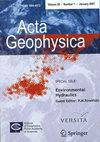Earthquake recurrence characteristics and earthquake occurrence probabilities in the Anninghe-Zemuhe-Daliangshan fault system, southeastern Tibetan Plateau
Abstract
The Anninghe-Zemuhe-Daliangshan fault system is one of the most severe seismic hazard regions in China, and it is of great practical significance to analyze the characteristics of seismicity and probability of earthquake occurrence in this region. The available earthquake catalogs from both the historical and instrumental are short and incomplete, making it challenging to accurately estimate the earthquake recurrence behavior and earthquake occurrence probabilities based on these catalogs. A simulated long-term earthquake catalog can largely make up for the shortcomings of the available observational catalogs. In this paper, we established a finite element dynamics model of the Anninghe-Zemuhe-Daliangshan fault system to simulate the earthquake cycles of the regional faults and generate a long-term simulated earthquake catalog that satisfies the regional geodynamic background. Based on the simulated earthquake catalog, we analyzed the characteristics of earthquake recurrence of different magnitudes at different locations along faults in the Anninghe-Zemuhe-Daliangshan fault system, the temporal distribution of these earthquakes, and the occurrence probabilities of strong earthquakes at various future time intervals on each fault. We found that the recurrence behavior of strong earthquakes at the same location along faults in the Anninghe-Zemuhe-Daliangshan fault system often has quasi-periodicity. We observed that the Weibull model can well describe the recurrence times of these strong earthquakes of each fault. Model results showed that the probability of a next strong earthquake to be occurred on the Anninghe fault is the highest in the entire fault system.

 求助内容:
求助内容: 应助结果提醒方式:
应助结果提醒方式:


